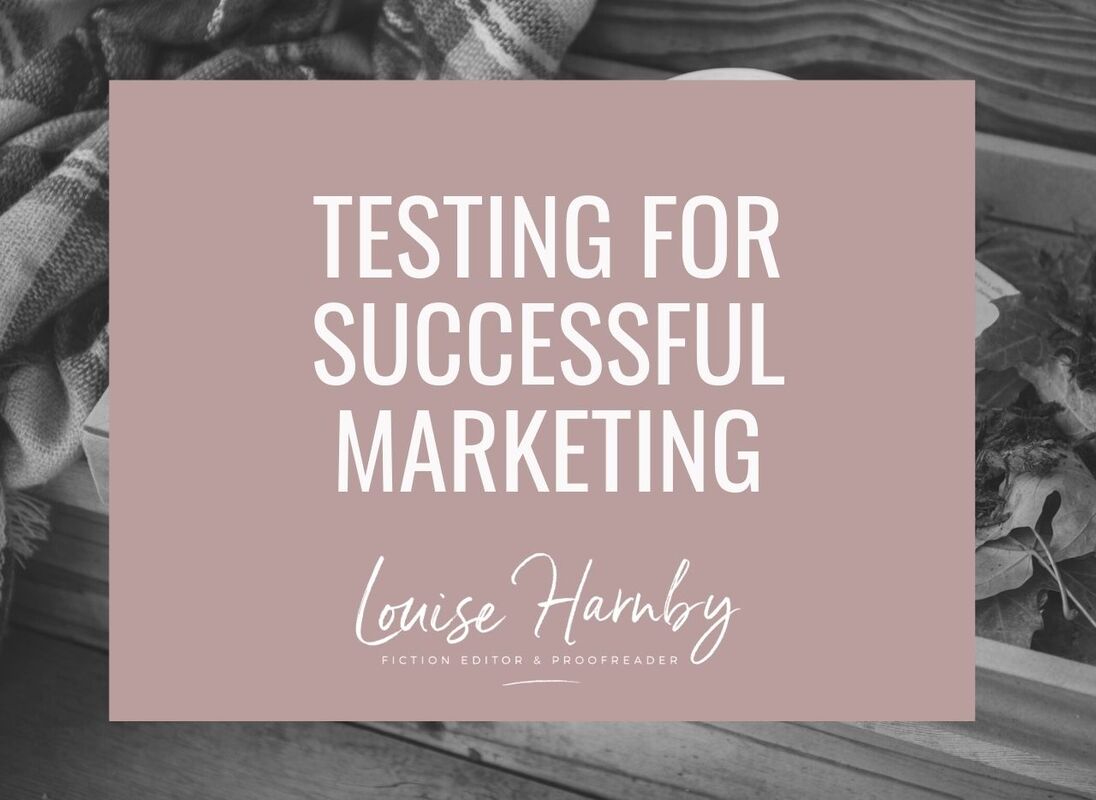|
This article considers the importance of testing in an editorial business marketing strategy.
If you're building a marketing strategy for your editing or proofreading business, you probably have a ton of questions. Some of those questions might look like this:
They’re perfectly good questions and our colleagues usually have some excellent answers. There’s nothing wrong with asking more experienced professionals for advice on how to go about promoting one’s business; indeed, I’d recommend it as one tool for deepening one’s marketing knowledge and stimulating one’s creative juices. However, it’s important to remember that ‘advice’ is just that – guidance and recommendations for action; advice is not a rule of thumb that needs to be followed without consideration of our own individual business goals, target clients groups, and required income streams. We all, too, have our own voices – some people shine when promoting their businesses face to face or over the telephone; others make more of an impact using their written communication skills. In brief, the marketing tools that work for me might not work as well for you, and vice versa. That’s why we need to incorporate testing into our marketing strategy. Testing involves experimenting with particular marketing activities over a fixed timescale, and evaluating the results. Testing allows you to discover which promotional activities are effective for generating business leads in particular segments of the editorial market. The results may well match the experience of many of your colleagues, but don’t be surprised if they differ too. Before you start … Before you begin testing, it’s crucial to consider what you are trying to say and to whom. Spend some time reviewing your business plan so that you have the following in mind:
A fictive case study Let’s return to just one of the questions that I posed at the beginning of this article and consider how testing offers a constructive approach to acquiring market knowledge that complements the advice gleaned from colleagues. ‘Is [directory name] worth advertising in?’ Ash is a recently qualified proofreader. He’s considering advertising his services in his national professional association’s online editorial directory. The cost would be $300 per annum, which is a big chunk of his marketing budget. He asks 3,000 of his fellow association members whether the directory has proved successful for them. He receives 30 responses, which at first sight is useful, but when he reads the replies in full, the advice is mixed.
Despite the mixed responses, there is some really useful information to be gleaned. Ash considers the following:
Ash reviews his business plan (including the skills he has, his career and educational background, the editorial training he’s carried out) and concludes that, although he has little experience, publishers are a good fit for his business model. The price tag of $300 is a little on the steep side for him, but he wants to acquire experience from publisher clients. Publishers seem like a core client group for the directory, though Ash is cognizant of the fact that he only has feedback from a small percentage of the society’s membership and he’s unsure whether their views are statistically significant. He decides to test the effectiveness of the directory for 1 year. He constructs a listing that is designed specifically to appeal to the publisher client group. In 12 months’ time he will evaluate the results. If the listing has generated his required income-to-cost ratio, he can continue investing in this marketing activity, confident that his money is well spent. If the listing doesn’t generate the desired results he will have two choices: (a) test a reworked version of the advertisement or (b) abandon the directory and explore other methods of making himself discoverable to publisher clients. Whatever the outcome, Ash’s test will provide him with evidence that he can use to make informed and confident decisions about how best to market his editorial business. What should you test? What you should test will depend on what you want to know. Here two tests I've carried out. Advertising with Reedsy I wanted to know whether creating a profile on Reedsy would make me more discoverable to independent fiction authors. It costs nothing financially to generate a listing, although Reedsy takes a percentage of any income earned. Feedback within the UK and the international editorial communities has been mixed. In May 2015, I decided to carry out a test over a 12-month period so that I could evaluate the potential benefits for my own business. Early results were positive – I picked up a high-value client within only a few weeks and completed several projects for him. The process was smooth and payment was timely. I continued to advertise on the platform and monitor the results. As of 2018, I receive requests to quote on a weekly basis. The test proved to me that Reedsy is a valuable lead generator for my business. The only way to find out if it works for you is to test it too. Adding video into my marketing mix I wanted to know whether videos would offer my clients and colleague-customers a valuable alternative way of consuming my written blog content. Would there be SEO benefits? Would the project generate sufficient additional high-value work opportunities and book/course sales to make the investment in time worthwhile? I began creating video content in 2017. As of 2018, my written content still drives more traffic to my website than my video content. However, certain videos, such as the 'Hello' one on my home page, a free webinar for colleagues on emergency marketing, and some tutorials on using Word's styles palette, have been popular. The emergency-marketing video led to a spike in sales of my books, and several clients have commented on how much they like being able to see the editor behind the website. The test leads me to believe that, in the main, I'm more likely to gain traction from videos that have a teaching or welcoming element, so I've decided to focus specifically on tutorial-based video content for now, and only as a supplement to my popular written content. Don’t mix things up Take care when carrying out more than one test. Multiple tests on one marketing tool are problematic – it won’t be clear why any changes to response rates, either positive or negative, are occurring. For example, if I decided I wanted to find ways of increasing the speed at which I receive payment, I might consider tweaking my invoice as follows:
It’s crucial that I test each of these things separately; otherwise, 12 months down the line, I’ll have no idea which of these tactics is working (or not working). It could well be that the message and emoticon are just as effective as the 5% discount. Unless I identify this by carrying out the tests separately, I’m needlessly throwing money out of the window. Tests can, of course, be carried out separately but simultaneously by dividing similar clients into groups, with one tweak applied to each group. So, in the invoicing case, I might divide all my publisher clients into three groups and send out invoices with the late-penalty payment info highlighted to group A, a 5% discount for early-bird payment to group B, and a thank-you message and emoticon smiley to group C. Then I would track the results for each group. Track the results Make sure you track test results. If, for example, you’re mailing your CV to a large number of publishers, and testing different designs, or different wording in the accompanying cover letter, make a note of who was sent what. That way you’ll be able to identify whether a particular test is generating a higher response rate. Codes can be a useful way of collating data if you’re want to work out where your best leads are coming from. Many editorial freelancers receive emails and phone calls from clients who don’t identify how they discovered them. Adding a distinct code to each call to action on your website’s Contact page, leaflet, business card, or advertisement helps you to distinguish the results of your marketing efforts. Likewise, if you are testing different pricing models with, say, students (e.g., a flat fee vs. $X per 1,000 words), you might issue them with different ordering codes if they decide to commission you (FF2015 for those offered a flat fee vs. PK2015 for those offered a price per 1,000 words); this would enable you to track which test generated the best likelihood of being hired. Summing up
An earlier version of this article was first published on An American Editor. More resources
Louise Harnby is a line editor, copyeditor and proofreader who specializes in working with crime, mystery, suspense and thriller writers.
She is an Advanced Professional Member of the Chartered Institute of Editing and Proofreading (CIEP), a member of ACES, a Partner Member of The Alliance of Independent Authors (ALLi), and co-hosts The Editing Podcast. Visit her business website at Louise Harnby | Fiction Editor & Proofreader, say hello on Twitter at @LouiseHarnby, connect via Facebook and LinkedIn, and check out her books and courses.
2 Comments
Kerry
7/10/2018 06:16:17 am
Another very useful post. I'll add it to the collection. I think you forgot one thing about marketing. You're also marketing 'you'. I think you're successful because you come across as helpful, informative, and friendly. People might follow the link because of curiosity or looking for information, but they come back because they like and trust the person.
Reply
Louise Harnby
7/10/2018 09:16:26 am
I didn't forget, Kerry! I agree with you. Building trust is key to maintaining the relationship, and I cover this in other marketing posts, and in my books and courses. In this post I specifically wanted to focus on the finding-out part of the process ... what we do to get that first point of engagement - where we advertise, what content we create, which social media channels we use, how we phrase our calls to action. All those things can be tested to see what works best.
Reply
Leave a Reply. |
BLOG ALERTSIf you'd like me to email you when a new blog post is available, sign up for blog alerts!
TESTIMONIALSDare Rogers'Louise uses her expertise to hone a story until it's razor sharp, while still allowing the author’s voice to remain dominant.'Jeff Carson'I wholeheartedly recommend her services ... Just don’t hire her when I need her.'J B Turner'Sincere thanks for a beautiful and elegant piece of work. First class.'Ayshe Gemedzhy'What makes her stand out and shine is her ability to immerse herself in your story.'Salt Publishing'A million thanks – your mark-up is perfect, as always.'CATEGORIES
All
ARCHIVES
July 2024
|
|
|
|

















 RSS Feed
RSS Feed





